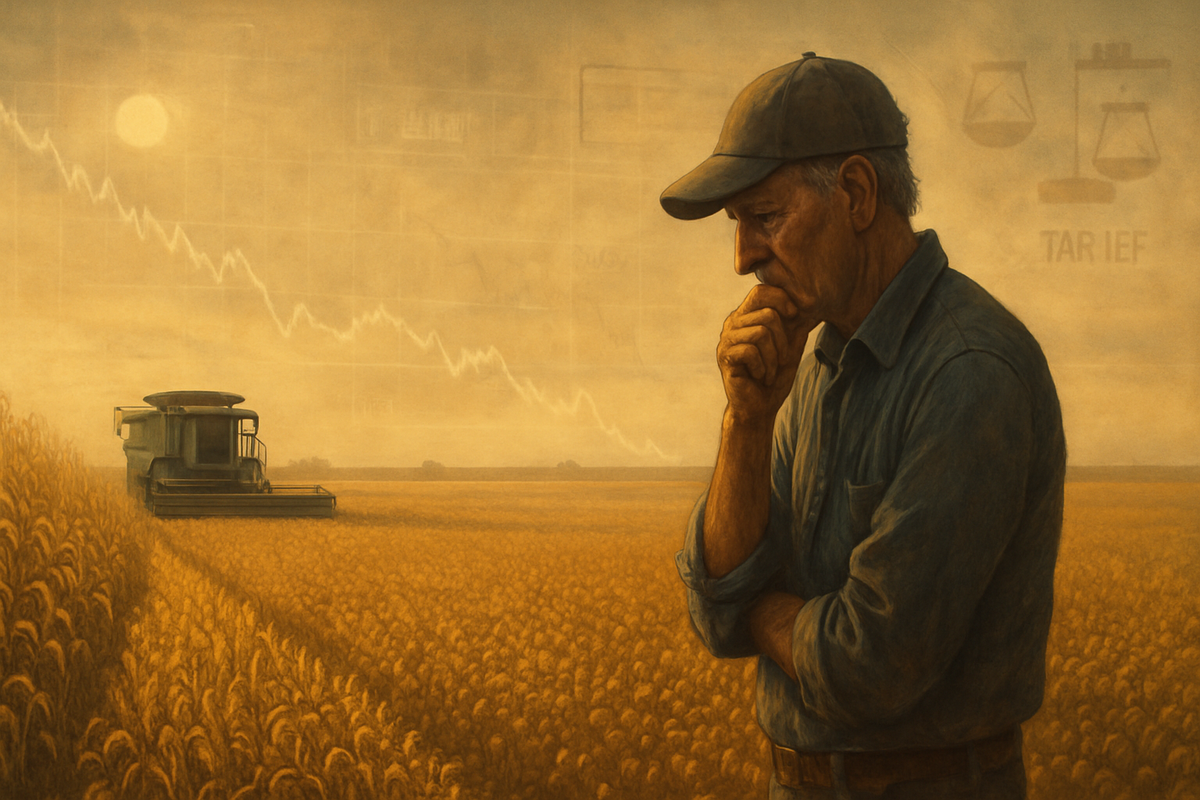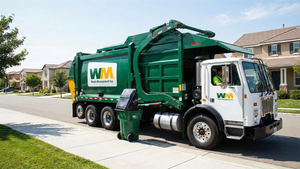Financial News
The Paradox of Plenty: Record Harvests Drown Farmers in Economic Uncertainty

Washington D.C., October 7, 2025 – The American agricultural heartland finds itself ensnared in a cruel paradox: while fields brim with record-breaking yields, the financial security of the nation's farmers continues to erode. Despite projections from the United States Department of Agriculture (USDA) indicating robust harvests for staple crops like corn and soybeans, farmers are struggling against a relentless tide of low commodity prices, soaring production costs, and renewed trade hostilities. This confluence of factors paints a grim picture for many agricultural producers, transforming what should be a season of prosperity into one of profound economic anxiety.
The immediate implications are severe, with many crop producers facing negative margins and increasing reliance on government support. This unsustainable dynamic not only threatens the livelihood of individual farm families but also casts a long shadow over the stability of the entire agricultural supply chain and the broader rural economy. As the industry grapples with the "paradox of plenty," stakeholders from Washington to Wall Street are watching closely to see how this critical sector will navigate its most challenging period in recent memory.
A Perfect Storm: High Costs, Low Prices, and Renewed Tariffs Batter the Farm Belt
The current predicament for farmers is a direct result of several compounding pressures converging in late 2024 and extending into 2025. The USDA projected record soybean and corn yields for 2024, with national average soybean yields estimated at 53.2 bushels per acre and corn yields at 183.1 bushels per acre, both surpassing previous records. While impressive from a production standpoint, this abundance has contributed to a global oversupply, pushing commodity prices downward. The World Bank forecasts a 4% decline in agricultural commodity prices for 2025, with grain prices, particularly for corn and wheat, expected to remain below their 2021-2023 highs. Corn prices are projected to stabilize between $5.50 and $6.00 per bushel, and soybeans between $12 and $13 per bushel in 2025, a significant step down from peak levels.
Compounding the issue of low prices are persistently high and volatile production costs. Fertilizer prices, after a brief respite, are climbing again in 2025, particularly for phosphates and potash, with nitrogen markets remaining mixed. Natural gas, a crucial feedstock for nitrogen fertilizers, is projected to see rising prices into late 2025 and 2026. Fertilizer has constituted between 33% and 45% of operating costs for corn and wheat since 2020. Fuel expenses, though edging downward in 2025, remain above pre-pandemic levels. Labor costs are a significant and growing burden, projected to reach over $53 billion across the agricultural industry in 2025, a nearly 50% increase since 2020. Interest expenses have also surged by 73% since 2020, adding to the financial strain.
Adding another layer of complexity, the Trump administration reintroduced tariffs in April 2025 on imported agricultural products. While intended to protect domestic farming, these tariffs are having a dual, often detrimental, impact. They increase input costs for U.S. farmers, with examples like a 10% tariff on potash imports from Canada. More critically, these tariffs have triggered retaliatory measures from major trading partners such as China, the European Union, and Mexico. Projections indicate U.S. agricultural exports could drop by 8% to 15% in 2025, threatening key markets for soybeans (to China), corn (to Mexico), and wheat (to the EU). This trade friction directly impacts export-dependent farms, leading to a loss of market share and further depressing domestic prices. Initial market reactions have been mixed, with some futures prices seeing modest increases while others, like cotton and dairy, have declined.
The combined effect of these pressures has led to a decline in net farm income in both 2023 and 2024. While the USDA forecasts a significant rebound in net farm income for 2025, projecting a 40% increase to $179.8 billion, this is largely attributed to a substantial increase in direct government payments, estimated at $40 billion, much of it tied to federal disaster aid. Crop receipts, however, are expected to fall to $236.6 billion in 2025, pushing many crop producers into a period of negative margins, forcing many farm households to rely heavily on off-farm income.
Corporate Crossroads: Who Wins and Who Loses in a Squeezed Market
The "paradox of plenty" creates a challenging environment across the agricultural value chain, segmenting potential winners and losers. Companies providing essential farm inputs are particularly vulnerable to farmers' tightened budgets. Corteva Agriscience (NYSE: CTVA), a major player in seeds and crop protection, and Deere & Company (NYSE: DE), a leading agricultural machinery manufacturer, could see reduced demand for their higher-margin products as farmers defer purchases or opt for more economical alternatives. While farmers still need basic inputs, the ability to invest in advanced seeds, precision agriculture technology, or new equipment is significantly curtailed when profitability is low. This could lead to a slowdown in sales growth and potentially impact their stock performance as investors react to a more cautious agricultural spending outlook.
Conversely, some sectors may find opportunities amidst the turmoil. Food processing giants like Archer-Daniels-Midland Company (NYSE: ADM) and Bunge Global SA (NYSE: BG) could potentially benefit from lower raw material costs for corn, soybeans, and wheat, improving their crushing and processing margins. However, this benefit might be offset by reduced global demand or logistical challenges stemming from trade disputes. Companies specializing in agricultural storage and logistics might also face fluctuating demand as commodity flows shift due to tariffs and changing export patterns. Furthermore, the increased reliance on government payments could indirectly benefit financial institutions that lend to farmers, provided the government support stabilizes farm incomes enough to ensure loan repayment.
Another potential area of impact lies with smaller, regional agricultural businesses that are deeply integrated into local farm economies. These entities, including local co-ops, independent input suppliers, and agricultural service providers, are often the first to feel the pinch when farmers' financial health deteriorates. Their ability to weather prolonged periods of low farmer profitability is often more limited than that of large, publicly traded corporations, potentially leading to consolidation or closures within the sector. The overall trend points towards a more cautious and cost-conscious agricultural market, forcing all players to adapt their strategies to a landscape where efficiency and resilience are paramount.
Broader Implications: Reshaping Rural Economies and Global Trade
The current agricultural crisis extends far beyond individual farm gates, carrying significant implications for broader industry trends, rural economies, and global trade dynamics. This period of squeezed margins is likely to accelerate consolidation within the farming sector, as smaller, less capitalized farms struggle to remain viable, potentially selling out to larger, more efficient operations. This trend, already evident over decades, could lead to a further reduction in the number of independent family farms and a shift towards industrialized agriculture. Simultaneously, the pressure to optimize costs and maximize yields is driving increased adoption of agricultural technology, from precision planting to data analytics, which could benefit companies offering these solutions in the long run, even if initial farmer investment is cautious.
The ripple effects on rural economies are profound. When farmers face financial distress, their spending on local goods and services decreases, impacting everything from small businesses and equipment dealers to local schools and healthcare providers. This can lead to a decline in rural employment and a further exodus of populations from agricultural areas, exacerbating existing challenges in these communities. The reliance on substantial government payments, while providing a critical safety net, also raises questions about the long-term sustainability of farm income and the role of federal policy in maintaining agricultural viability.
From a regulatory and policy perspective, the renewed tariff disputes highlight the fragility of global trade agreements and the vulnerability of the agricultural sector to geopolitical tensions. The current administration's trade policies are forcing a re-evaluation of supply chain resilience and the diversification of export markets. Historically, similar periods of agricultural oversupply coupled with economic downturns, such as the farm crises of the 1980s, led to significant government intervention and structural changes in farm policy. While the specifics differ, the current situation draws parallels in the need for robust safety nets and strategic planning to prevent widespread farm failures and ensure food security. The ongoing debates around the next Farm Bill will undoubtedly be shaped by these pressing economic realities.
What Comes Next: Adaptations, Opportunities, and a Shifting Landscape
Looking ahead, the agricultural sector faces a period of critical adaptation and strategic recalibration. In the short term, farmers will continue to focus intensely on cost management, exploring every avenue to reduce expenses, from optimizing fertilizer application to delaying equipment upgrades. Many may also pivot towards higher-value crops or diversified operations, including direct-to-consumer sales, to reduce reliance on volatile commodity markets. The effectiveness of government support programs, particularly the distribution of disaster aid and the impact of the new tariffs, will be crucial in determining the immediate financial health of farms.
In the long term, the industry is likely to see accelerated innovation in sustainable farming practices that reduce input costs and enhance resilience to climate change. Companies developing drought-resistant seeds, biological pest control, and advanced irrigation systems could find growing market opportunities. There may also be a renewed push for new trade agreements or the renegotiation of existing ones to stabilize export markets and reduce the uncertainty caused by tariff disputes. Farmers will increasingly need to become astute business managers, leveraging data and technology to make informed decisions and manage risk more effectively.
Potential scenarios range from a gradual stabilization of commodity prices and a more balanced cost structure, supported by effective policy interventions, to a more prolonged period of low profitability leading to significant farm consolidation and structural changes in agricultural production. Investors should watch for shifts in global demand, particularly from emerging markets, and the evolution of trade relations. The development of new biofuel mandates or other industrial uses for agricultural commodities could also provide demand-side support. Ultimately, the coming months will test the resilience of the agricultural sector and its capacity for innovation and adaptation in the face of persistent economic headwinds.
Wrap-Up: Navigating the New Normal in Agriculture
The paradox of record crop yields failing to translate into financial security for farmers represents a profound challenge for the agricultural sector in late 2025. The confluence of low commodity prices, stubbornly high production costs, and the disruptive reintroduction of tariffs has created an environment of significant economic uncertainty for crop producers. While government payments are providing a crucial, albeit temporary, lifeline, the underlying market dynamics continue to squeeze margins and necessitate fundamental shifts in farming practices and policy.
Moving forward, the market will be characterized by increased volatility and a heightened focus on efficiency and risk management. Companies across the agricultural value chain, from input suppliers to food processors, will need to adapt their strategies to a more cost-conscious and unpredictable landscape. Investors should closely monitor agricultural commodity price trends, the effectiveness of government support programs, and developments in international trade policy. The ability of farmers to innovate, diversify, and leverage technology will be key to navigating this "new normal."
The lasting impact of this period will likely be a more consolidated, technologically advanced, and potentially more resilient agricultural sector, albeit one that has undergone significant structural change. The coming months will be critical in determining the trajectory of American agriculture, highlighting the urgent need for comprehensive solutions that address both market imbalances and the enduring financial pressures on the nation's food producers.
This content is intended for informational purposes only and is not financial advice
More News
View More




Recent Quotes
View MoreQuotes delayed at least 20 minutes.
By accessing this page, you agree to the Privacy Policy and Terms Of Service.



